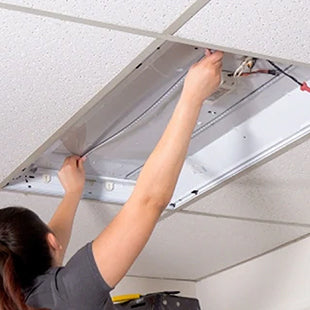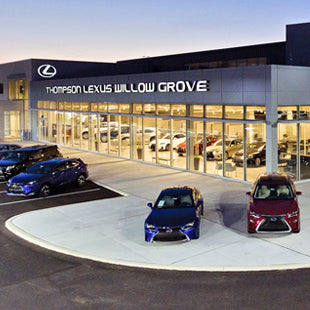How to Calculate the Return on Investment (ROI) for LED Lighting
You’ve heard that switching to LED lighting can provide significant energy savings, reduce maintenance costs, and improve lighting quality for businesses. The question is, will it be worth it for your business?
A simple cost-benefit analysis can help you determine that. A return on investment (ROI) calculation will give you the numbers you need to make that analysis.
This article serves as a guide on how to calculate the ROI your business would receive for switching to LED lighting.
Step 1: Energy Cost Savings
The first step in calculating the ROI for LED lighting upgrades is to determine the potential savings in energy costs. You can use ELEDLights’ fast & easy Energy Savings Calculator to calculate this step, or do it manually using the steps below:
- What wattage lamps does your current lighting system use?
- What is the wattage of the LED lights you would replace your current lights with?
- Calculate the difference in wattage between the two lighting systems (step 1 - step 2).
- Multiply that difference by the total number of lamps in your lighting system. This is the total difference in wattage.
- Calculate your total annual lighting hours by multiplying the number of hours your lights are on per day by the number of days per year that your lights are in use.
- Calculate your annual energy use savings by multiplying the difference in total wattage (from step 4) by the total annual lighting hours (from step 5).
- Convert the annual energy use savings to kilowatt-hours (kWh) by dividing by 1,000.
- Look up the electricity rate you’re paying in dollars per kWh.
- Multiply your annual energy savings in kWh (from step 7) by your electricity rate to get your total annual energy cost savings in dollars.
For example, let’s say your current lighting system uses twenty 400W metal halide lamps that you could replace with 150W LED lamps. If your lights are on 12 hours/day, 365 days/year, and your electricity rate is 12.5 cents/kWh:
(400W metal halide - 150W LED) x 20 lamps x 12 hours per day x 365 days per year ÷ 1000 = 21,900 kWh
21,900 kWh x $0.125/kWh electric rate = $2737.50 in annual energy savings
Step 2: Maintenance Costs
Next, determine the maintenance costs associated with your current lighting system. To calculate these maintenance costs, do the following steps:
- What is the average lifespan of your current lighting system in hours? As a general guide:
- Metal halide bulbs last 6,000 to 15,000 hours.
- High pressure sodium lasts 12,000 to 24,000 hours.
- Fluorescent lasts 20,000 to 30,000 hours.
- Halogen lasts 2,000 to 4,000 hours.
- What is the average lifespan of the proposed LED lighting system in hours? For most lights that ELEDLights sells, this is 50,000 operating hours.
- Calculate the number of times you would need to replace your current lighting system over the course of the LED system’s lifespan by dividing the LED lifespan by your current system’s lifespan (step 2 ÷ step 1).
- Estimate the cost of replacing a lamp in your current system, including any additional maintenance costs, such as labor and potential scaffolding or bucket truck rentals.
- Multiply the number of times you would replacement a lamp (from step 3) by the cost per replacement (from step 4) to get the maintenance cost per lamp.
- Multiply the maintenance cost per lamp (from step 5) by the total number of lamps to get the total maintenance cost for your current lighting system.
Let’s say you are considering replacing 10,000-hour metal halide with 50,000-hour LED lighting. If your cost for a metal halide lamp is typically $30, and it costs you $50 for scaffolding rental plus $0 for labor, the maintenance cost you’d pay for your 10,000-hour metal halide lamps over a 50,000 hour period would come out to $13,000:
(50,000 hours/10,000 hours) * ($30 bulb + $50 scaffold + $50 labor) * 20 lamps =
$13,000 in maintenance costs for metal halide over the lifespan of an LED lamp
Step 3: Account for Valuable Utility Rebates and Incentives
Many utility companies offer rebates and incentives to businesses that upgrade to energy-efficient LED lighting systems. To factor these into your ROI calculation:
- Research the available rebates and incentives in your area. ELEDLights makes it easy to see what instant incentives your utility offers with our Find Instant Rebates feature, available on the shopping page of every rebate-eligible light in our store. You’ll find it right below the light’s price. You can browse all our rebate-eligible lights here. If our finder doesn’t pull up any instant savings, that doesn’t mean there aren’t other rebates or incentives available to you from your utility. You can have our team do a quick check into all your utility’s programs; simply fill out the short "Does Our Business Qualify for Lighting Incentives & Rebates?"
- Once you have a per-lamp rebate estimate, determine the total value of the incentives you qualify for by multiplying the per-light rebate by the number of lights you need.
For example, if you’re eligible for a $100/light rebate on your twenty lights, that’s $2,000 you’ll get back on your lighting purchase.
If you’re not eligible for rebates, you can still find savings for your light purchase. Consider ordering lights for your whole property at once, rather than doing it in stages, which will allow you to access money-saving bulk discounts.
Look into what other savings may be available from your lighting supplier as well, such as a discount for using your own shipping account or for paying by check or money order. For example, when you place your order over the phone, ELEDLights can give you 5% off if you use your own shipping account and 2% off if you pay by check or money order instead of credit card.
Step 4: Calculate the Return on Investment (ROI)
With the energy savings, maintenance cost savings, and utility rebates & incentives accounted for, you can now calculate the ROI for your LED lighting upgrade:
- Calculate the total cost of the LED lighting system, including cost per light plus installation costs and any applicable taxes.
- Subtract the value of any utility rebates or lighting supplier discounts from the total cost of your new lighting system to get the net cost of the LED lighting system.
- Calculate how long in years your LED lighting system is expected to operate without maintenance. For this, you multiply hours per day your lighting is in operation by number of days per year it’s in operation.
- Divide the maintenance cost savings by this number of years.
- Add the annual energy cost savings to the annual maintenance cost savings to determine the total annual savings.
- Divide the net cost of the LED lighting system by the total annual savings to get the payback period in years.
- Calculate the ROI percentage for the first year by dividing the total annual savings by the net cost of the LED lighting system and multiplying by 100.
- Calculate the ROI percentage for the lifetime of the LED lighting system by multiplying the annual energy cost savings by the number of years of expected operating life. Then add that number to the maintenance cost savings for the total lifetime savings, and divide that total lifetime savings by the net cost of the LED lighting system. Finally, multiply it by 100.
For example, if new LED lights cost $150 per fixture plus $100 to install, you qualify for $100/fixture in rebates, and you need 20 lights that will run 12 hours a day every day of the year, and you’ve calculated that you will save $13,000 in maintenance costs over the life of the LED lights plus $2,737 in energy costs yearly, then:
- ($150 light + $100 installation) * 20 lights = $5,000 cost for new lighting system
- $5,000 cost - ($100 rebate * 20 lights) = $3,000 net cost for new lighting system
- 50,000 ÷ (12 hours per day * 365 days per year) = 4 years expected operating life
- $13,000 maintenance cost savings ÷4 years = $1,140/year maintenance cost savings
- $2,737 annual energy savings + $1,140 annual maintenance savings = $3,877 total annual savings
- $3,000 net cost of new system ÷ $4,053 annual savings = 0.74 of a year x 12 months = 9 months to pay back the cost of the new system
- $3,877 annual savings ÷ $3,000 net cost * 100 = 129% ROI in the first year of installing your lighting system
- (($2,737 annual energy savings x 11.4 years) + $13,000 total maintenance savings) ÷ $3,000 net cost * 100 = 1473% ROI over the life of the system
Calculating the return on investment for LED lighting upgrades can help you make an informed decision about the benefits of switching to LED lighting. By considering energy savings, maintenance cost savings, and utility rebates, you can get a better grasp on the financial implications of upgrading your lighting.
With a clear understanding of the ROI, you’re ready to confidently invest in LED lighting upgrades, knowing you’re making a smart decision for your business that will pay off in the long run.
Now all you need to do is shop for your new lights.





